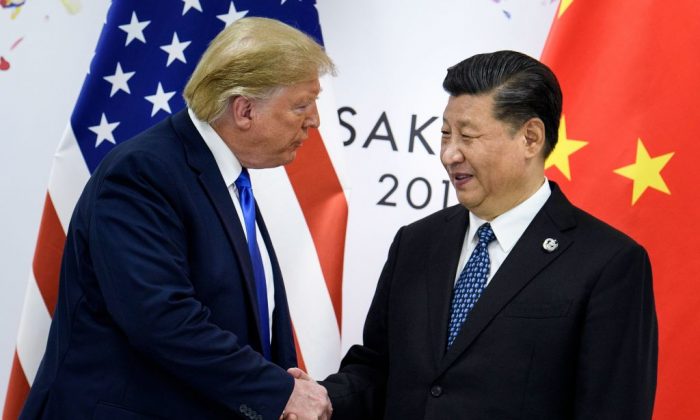Jared Kushner Says He Is ‘Cleaning up the Messes’ Left by Joe Biden
WASHINGTON—Whether the United States and China will sign the first part of a trade deal at the APEC meetings in Chile isn’t yet certain, and one obstacle in the ongoing talks is China’s stance on intellectual property. This is one of the most problematic issues in the trade talks, as Beijing wouldn’t “move the needle” much to meet U.S. demands, a China expert says.
Optimism surged after the world’s two largest economies announced on Oct. 11 that they had reached a partial trade agreement, in principle, on intellectual property, financial services, and agriculture.
President Donald Trump called the agreement “a very substantial phase one deal,” that suspended October tariff hikes on Chinese goods. Beijing has agreed to boost purchases of U.S. farm goods and made progress in opening its financial services markets to U.S. banks.
However, there’s still a sense of skepticism when it comes to Chinese concessions on intellectual property (IP) rights.
“I think at this point the speculation is essentially that China looks to repackage actions it has already taken over the past year or so to strengthen IP in China,” said Jude Blanchette, Freeman chair in China Studies at the Center for Strategic and International Studies (CSIS) on Oct. 29.
Speaking at a press briefing hosted by the CSIS, Blanchette said “IP protection is one of the thorniest issues” in the trade talks.
China has passed legislation to improve market access and strengthen IP protection in the past year. However, there have been issues with the enforcement of these laws. And the issues aren’t just limited to rules and enforcement.
“You’ve got not only state IP theft, but you have a lot of commercial IP theft that’s happening, too. And a lot of it is happening in a sort of ways that are just outside of the regulatory apparatus’ ability to catch it,” Blanchette said.
It would be very hard to address all the IP issues in the phase one deal, he noted, adding that there would be more discussions at a later phase to “see something meaningful.”
Trump earlier indicated that there could be two or three phases in China trade talks. He said phase two negotiations would start “almost immediately after” the completion of the phase one deal.
Blanchette questions Beijing’s seriousness in protecting foreign intellectual property.
“I think politically speaking, for China, they’re not looking to make—whether in phase one, phase two, or phase three—large concessions to the United States that fundamentally undermine the party leadership’s ability to deliver economic growth and national strength and power,” he said.
“Which is why we’ve seen again and again China really hasn’t moved the needle in terms of what it’s offering to the United States on the trade war.”
Meeting in Chile
Leaders of the United States and China look forward to signing the phase one deal in mid-November at the Asia-Pacific Economic Cooperation (APEC) summit in Chile.
Both sides are actively working to finalize the agreement for signature before then. However, there are still uncertainties about the timing of a bilateral meeting between Trump and Chinese leader Xi Jinping.
Trump earlier said that both sides could be ahead of the schedule for inking the deal but didn’t elaborate on the timing.
“We are looking probably to be ahead of schedule to sign a very big portion of the China deal, we’ll call it phase one, but it’s a very big portion,” he told reporters on Oct. 28. “Probably, we’ll sign it. I imagine the meeting is scheduled for Chile.”
The South China Morning Post, citing a source familiar with the arrangements, reported on Oct. 28 that Trump and Xi were tentatively scheduled to meet and sign the deal on Nov. 17 “if everything goes smoothly.”
However, the White House denied such reports, telling The Epoch Times there’s “no meeting to announce at this time.”
Chile, the host of the APEC summit, has seen serious violence and riots during the past two weeks triggered by a 4-cent increase in subway fares. At least 20 people have died and more than 1,000 have been injured in the turmoil that has swept the country.
“This came very unexpectedly,” said Michael Matera, a senior fellow and director of the Americas program at the CSIS.
“This is being explained as a reaction from the lower-middle classes to very high levels of inequality in Chile, frustration over the inability to access paid education, inability to access a two-tiered health system that is out of reach for the majority of Chilean citizens,” he said at the press briefing.
More than 1 million people joined the anti-government rally on Oct. 25 in the capital Santiago, calling for social justice.
Despite the unrest, “Chilean authorities are saying very clearly the summit is going forward,” Matera said.
“There may be some minor adjustments to the schedule. That said, we’re going to have to see what happens between now and the 15th of November.”
This article is from the Internet:China’s IP Theft Remains a Thorny Issue in Trade Talks
Vaping-Related Deaths Often Linked to Products With THC, a Cannabinoid
